AMD's Richland vs. Intel's Haswell GPU on the Desktop: Radeon HD 8670D vs. Intel HD 4600
by Anand Lal Shimpi on June 6, 2013 12:00 PM ESTMetro: Last Light
Metro: Last Light is the latest entry in the Metro series of post-apocalyptic shooters by developer 4A Games. Like its processor, Last Light is a game that sets a high bar for visual quality, and at its highest settings an equally high bar for system requirements thanks to its advanced lighting system. This doesn’t preclude it from running on iGPUs thanks to the fact that it scales down rather well, but it does mean that we have to run at fairly low resolutions to get a playable framerate.
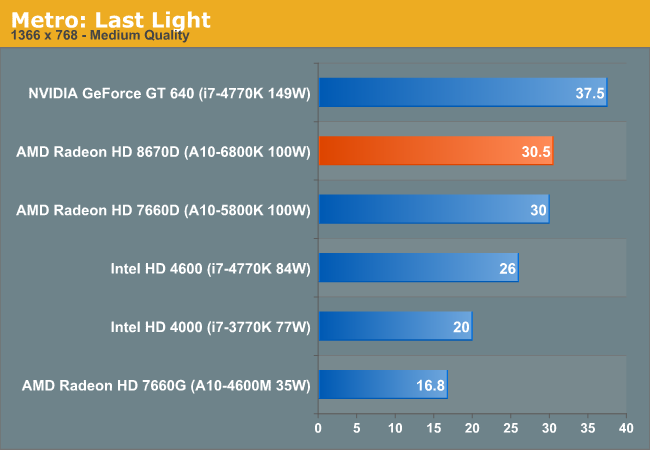
Looking at desktop parts alone, Intel really suffers from not having a socketed GT3 SKU. Although HD 4600 is appreciably faster than HD 4000 (+30%), both Trinity and Richland are around 17% faster than it. As you'll see, Metro ends up being one of the smaller gaps between the two in our suite.
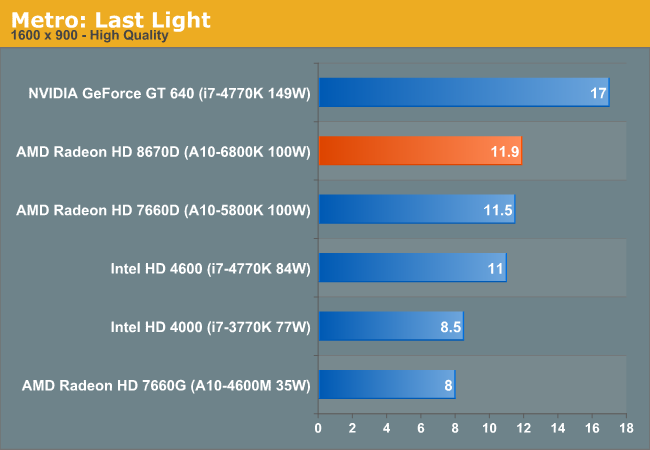
As memory bandwidth becomes the ultimate bounding condition, the gap between Richland and Haswell shrinks considerably. Note that on the HD 4600 side, the difference between DDR3-1333 and DDR3-2400 is only 10% here. Given the limited performance of the 20 EU Haswell GPU configuration, it doesn't seem like Intel is all that bandwidth limited here.
BioShock: Infinite
Bioshock Infinite is Irrational Games’ latest entry in the Bioshock franchise. Though it’s based on Unreal Engine 3 – making it our obligatory UE3 game – Irrational had added a number of effects that make the game rather GPU-intensive on its highest settings. As an added bonus it includes a built-in benchmark composed of several scenes, a rarity for UE3 engine games, so we can easily get a good representation of what Bioshock’s performance is like.
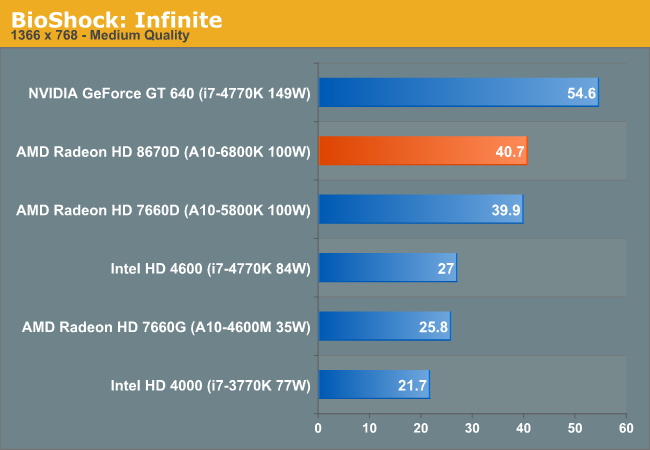
If Metro was an example of the worst case scenario for Richland, BioShock: Infinite is the best case scenario. Here the Radeon HD 8670D holds a 50% performance advantage over Intel's HD 4600 graphics.
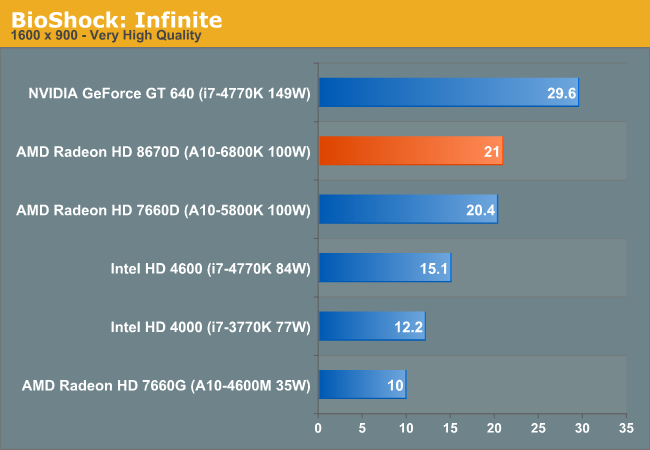
The gap narrows a bit at higher resolution/quality settings, but it's still 39%.
Sleeping Dogs
A Square Enix game, Sleeping Dogs is one of the few open world games to be released with any kind of benchmark, giving us a unique opportunity to benchmark an open world game. Like most console ports, Sleeping Dogs’ base assets are not extremely demanding, but it makes up for it with its interesting anti-aliasing implementation, a mix of FXAA and SSAA that at its highest settings does an impeccable job of removing jaggies. However by effectively rendering the game world multiple times over, it can also require a very powerful video card to drive these high AA modes.
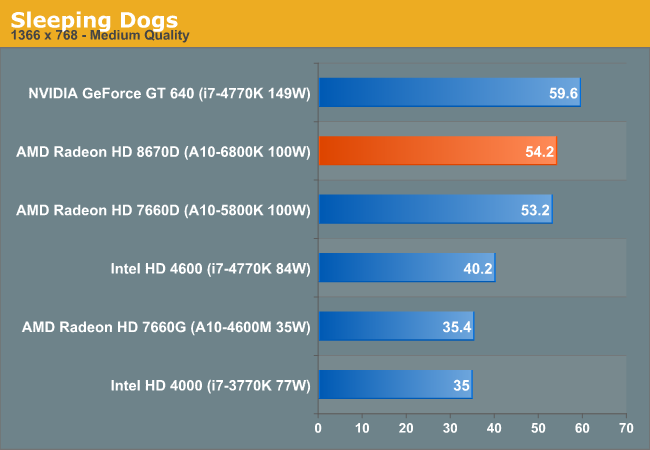
Richland is approaching 60 fps in our Sleeping Dogs benchmark at medium quality, definitely not bad at all. The advantage over Intel's HD 4600 is 34%.
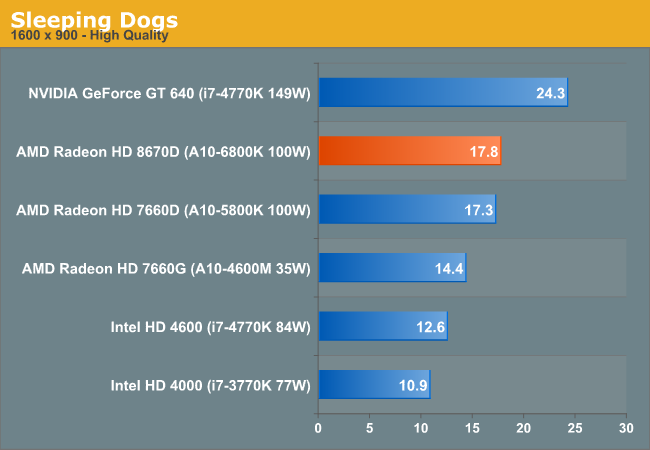
The performance advantage grows a bit at the higher quality/resolution settings, however we drop below the line of playability. With most of these games, you can trade off image quality for resolution however.
Tomb Raider (2013)
The simply titled Tomb Raider is the latest entry in the Tomb Raider franchise, making a clean break from past titles in plot, gameplay, and technology. Tomb Raider games have traditionally been technical marvels and the 2013 iteration is no different. iGPUs aren’t going to have quite enough power to use its marquee feature – DirectCompute accelerated hair physics (TressFX) – however even without it the game still looks quite good at its lower settings, while providing a challenge for our iGPUs.

Tomb Raider is another title that doesn't put Richland in the best light, but it still ends up around 23% faster than Haswell GT2.
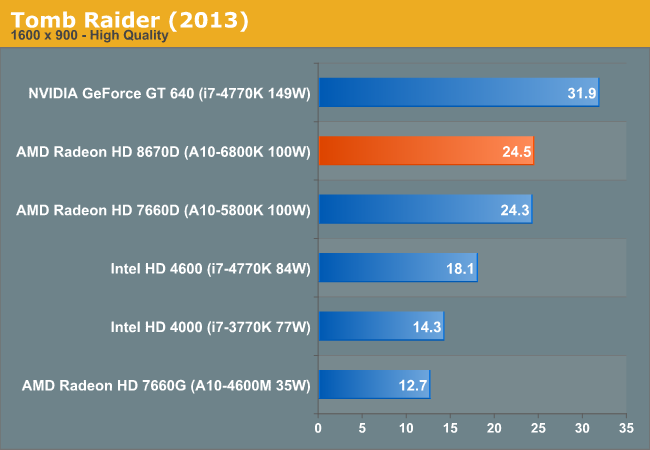
Battlefield 3
Our multiplayer action game benchmark of choice is Battlefield 3, DICE’s 2011 multiplayer military shooter. Its ability to pose a significant challenge to GPUs has been dulled some by time and drivers at the high-end, but it’s still a challenge for more entry-level GPUs such as the iGPUs found on Intel and AMD's latest parts. Our goal here is to crack 60fps in our benchmark, as our rule of thumb based on experience is that multiplayer framerates in intense firefights will bottom out at roughly half our benchmark average, so hitting medium-high framerates here is not necessarily high enough.
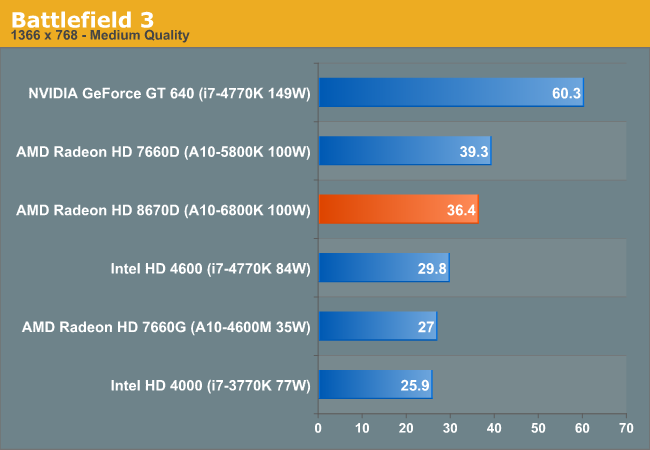
Richland's performance in Battlefield 3 climbs around 30% over the HD 4600 regardless of quality/resolution.

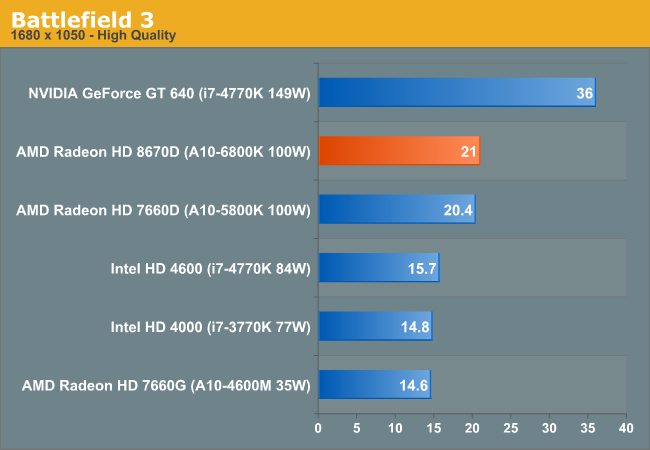
Crysis 3
With Crysis 3, Crytek has gone back to trying to kill computers, taking back the “most punishing game” title in our benchmark suite. Only in a handful of setups can we even run Crysis 3 at its highest (Very High) settings, and the situation isn't too much better for entry-level GPUs at its lowest quality setting. In any case Crysis 1 was an excellent template for the kind of performance required to drive games for the next few years, and Crysis 3 looks to be much the same for 2013.

Crysis is another benchmark where we see an increase in performance in the low 30% range.
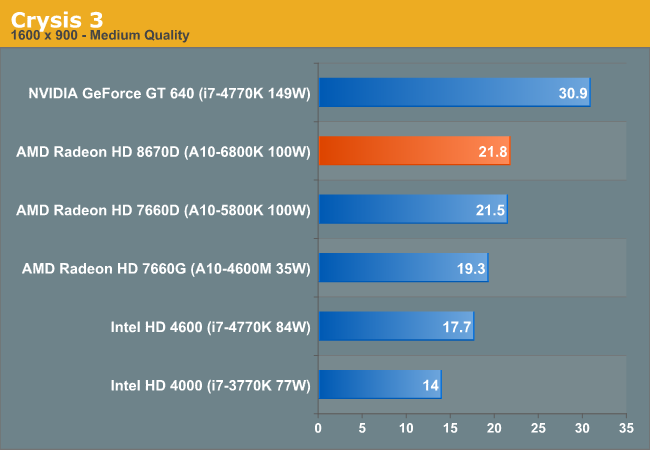











102 Comments
View All Comments
whatthehey - Thursday, June 6, 2013 - link
I can't imagine anyone really wanting minimum quality 1080p over Medium quality 1366x768. Where it makes a difference in performance, the cost in image quality is generally too great to be warranted. (e.g. in something like StarCraft II, the difference between Low and Medium is massive! At Low, SC2 basically looks like a high res version of the original StarCraft.) You can get a reasonable estimate of 1080p Medium performance by taking the 1366x768 scores and multiplying by .51 (there are nearly twice as many pixels at 1080p as at 1366x768). That should be the lower limit, so in some games it may only be 30-40% slower rather than 50% slower, but the only games likely to stay above 30FPS at 1080p Medium are older titles, and perhaps Sleeping Dogs, Tomb Raider, and (if you're lucky) Bioshock Infinite. I'd be willing to wager that relative performance at 1080p Medium is within 10% of relative performance at 1366x768 Medium, though, so other than dropping FPS the additional testing wouldn't matter too much.THF - Friday, June 7, 2013 - link
You're wrong. Most people who take Starcraft 2 seriously are actually playing on the highest resolution they can get, with the low detail setting. Sure, the game looks flashier, but it's easier to play with less detail. All pros do it.Also, as for myself, I like to have the games running on native resolution of the display. It makes "alt-tabbing" (or equivalent thereof on Linux) much more responsive.
Calinou__ - Friday, June 7, 2013 - link
+1, "Low" in today's AAA games is far from ugly if you keep the texture detail to the maximum.tential - Thursday, June 6, 2013 - link
This is my BIGGEST pet peeve with some reviewers who will test 1080p and only show those results when testing these types of chips. All of the frame rates will be unplayable yet they'll try to draw "some conclusion" from the results. Test resolutions where the minimum frame rate is like 20-25 fps by the contenders so I can see how smooth it actually will be when I play.I didn't purchase an IGP solution to play 10 FPS games at 1080p. I purchased it to play low resolution at OK frame rates.
zoxo - Thursday, June 6, 2013 - link
I always start by setting the game to my display's native res (1080p), and then find out at what settings can I achieve passable performance. I just hate non-native resolution too much :(taltamir - Thursday, June 6, 2013 - link
because you render at a lower res and upscale with iGPUsjamyryals - Thursday, June 6, 2013 - link
Love that Die render on the first page. It's dumb, but I always like seeing those.Homeles - Thursday, June 6, 2013 - link
It's not dumb. You can learn a lot about CPU design from them.Bakes - Thursday, June 6, 2013 - link
Not that it really matters but I think he's saying it's dumb that he always likes seeing those.Gigaplex - Thursday, June 6, 2013 - link
Homeles' comment could be interpreted in a way that agrees with you and says it's not dumb to like seeing them because you can learn lots.